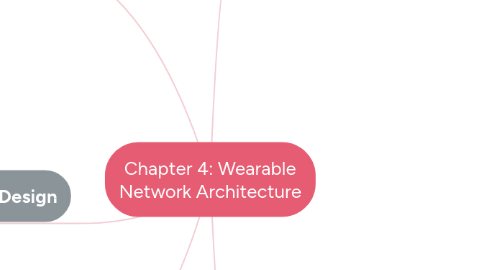
1. Communication Technologies
1.1. Wired
1.1.1. Optical
1.1.2. Electrical
1.2. Wireless
2. Network Topology
2.1. Bus Topology
2.1.1. All communicating nodes are connected to the same line
2.2. Star Topology
2.2.1. Every node in the network has its own connection to a common central node which acts as a router to transmit messages
2.3. Hierarchical Topology
2.3.1. It consists of two or more star networks arranged in a tree hierarchy
2.4. Ring Topology
2.4.1. All nodes form together a closed loop where messages flow only in one direction
2.5. Mesh Topology
2.5.1. Two or more paths exist between every pair of nodes in the network
3. Wearable System Design
3.1. Methodology
3.1.1. Requirement Specification
3.1.2. Scenario Generation
3.1.3. Option Reduction
3.1.4. Design and Evaluation
4. Wearable Network Requirement
4.1. Power Ditribution
4.1.1. Single power source strategy
4.1.1.1. Less total weight and volume
4.1.1.2. Individual modules become smaller and lighter
4.1.1.3. Tolerate high rates of discharge for a longer time
4.1.1.4. Easier to increase the system operational lifetime
4.1.1.5. Enables possibility of exchanging battery without the need to power down the system
4.1.1.6. Enables the use of secondary batteries for all modules which is preferred in wearable applications for economic and environmental issues
4.1.1.7. Reduces the complexity and the cost of the mechanical design
4.1.1.8. Maintenance and logistics costs are lower
4.1.1.9. More difficult to extend the capability of the wearable system by adding new modules
4.1.1.10. Cable routing diminishes the flexibility of the system and increases the weight and volume of the whole system
4.1.2. Multi power source strategy
4.2. Data Communication
4.2.1. Bandwidth needs: hundreds of kilobits per second
4.2.2. To support video streaming: Several megabits per second (video-recorder-quality: 1.2 Mbps, broadcast-quality: 5 Mbps)
5. Proposed Wearable Architecture
5.1. Power Line Communication
5.1.1. Technology for transmitting data using already existing alternating current (AC) power lines
5.2. Electrically Conductive Textile as Transmission Line
5.2.1. Metal materials enable the highest conductivity
5.2.1.1. Blend conductive fibres or foils with non-conductive fibres or yarn
5.2.1.2. Coating non-conductive fibres with a thin conductive layer
